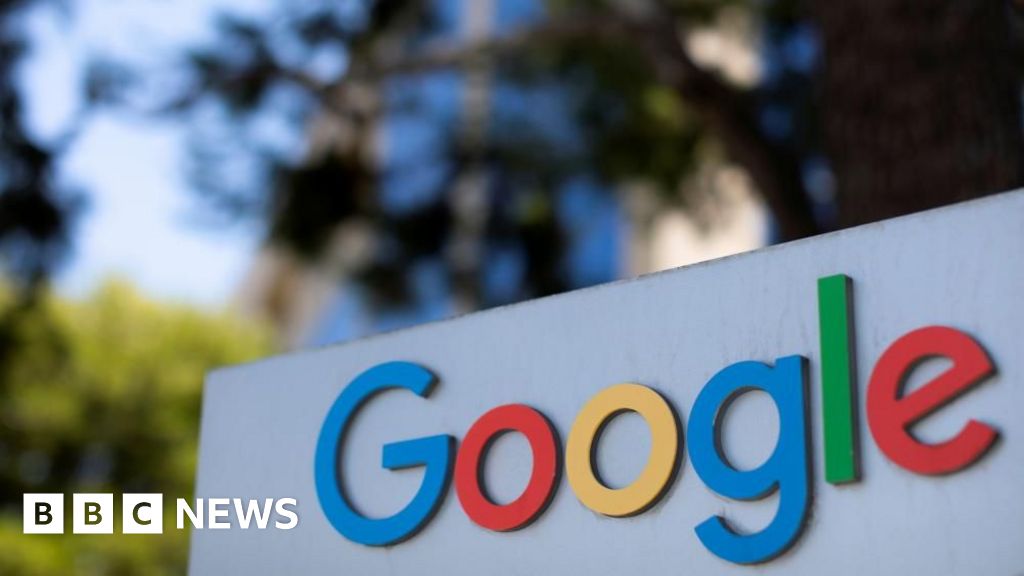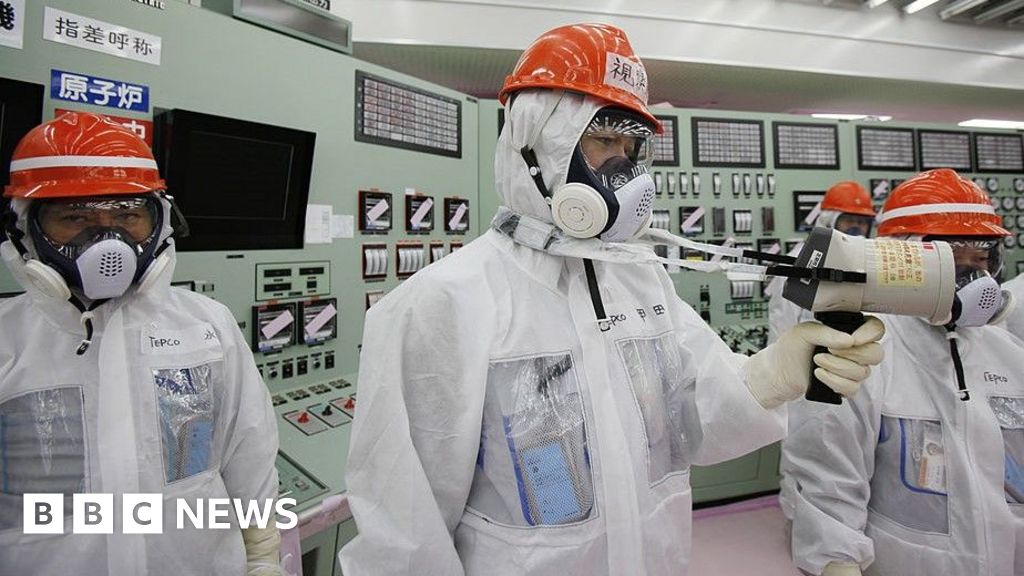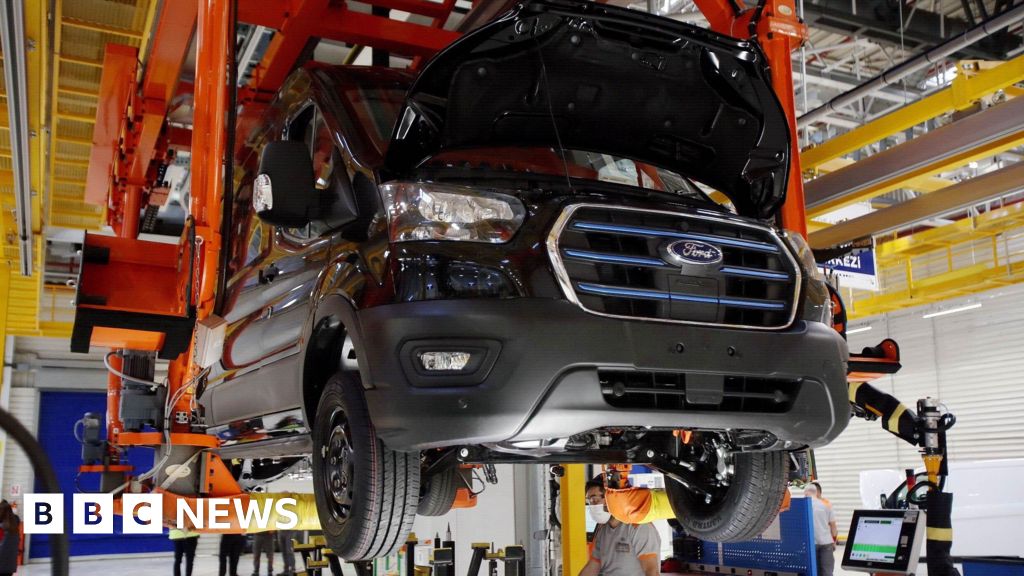
 BBC
BBC
It has been a recurrent theme of this US presidential campaign - has the US economy performed better under Joe Biden or Donald Trump?
“By many indicators our economy is the strongest in the world,” Democratic Vice-President Kamala Harris has claimed.
Trump, the Republican nominee and former president, says he created the "greatest economy in the history of our country", and the Biden-Harris administration has ruined it.
We have looked at some key indicators to compare economic performance under the two presidencies.
US economic growth
Although the impact of Covid has made comparison difficult, both presidents can count some notable economic successes despite wages struggling to keep up with price increases in recent years.
First, let's look at economic growth using Gross Domestic Product (GDP) - the value of all goods and services in the US economy.
There was a dramatic collapse in this figure during Covid as many businesses shut.
Following the pandemic, the economy bounced back strongly under Trump and recovered better than many other western countries.
This has continued under Mr Biden, with the US producing the strongest pandemic recovery within the G7 as measured by GDP.

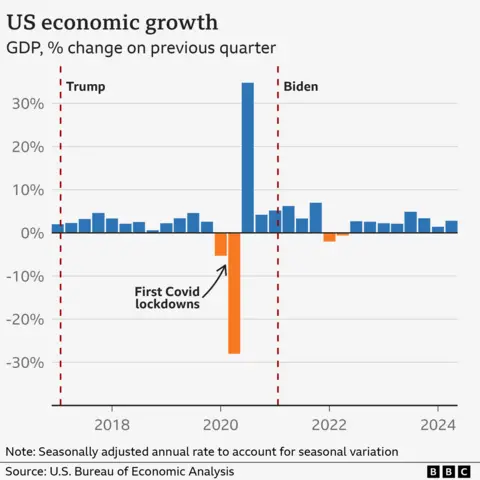 BBC News
BBC News
But over Trump's four years in office, it was not the greatest economy in US history, as he likes to claim.
Between January 2017 and January 2021, average annual growth rate was 2.3%.
This period includes the slowdown and recovery of the economy as a result of the Covid pandemic.
Under the Biden administration so far, this figure is 2.2% - so almost the same.
There have been periods in the past when GDP growth was significantly higher than the average under both Trump and Biden, such as in the 1970s.

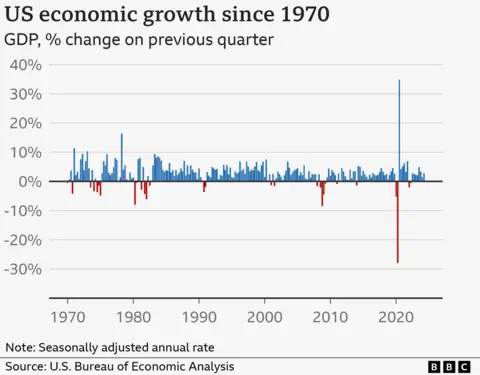 BBC News
BBC News
Inflation
The rate at which prices are rising has been a big issue in the campaign.
Prices rose significantly during the first two years under Mr Biden - hitting a peak of 9.1% in June 2022.
Trump has said the US has experienced “the worst inflation we've ever had”.
But that's not true - inflation was last above 9% in 1981, and it has been much higher than that at several other points in US history.
Inflation has now fallen to around 3% - but it remains higher than when Trump left office.

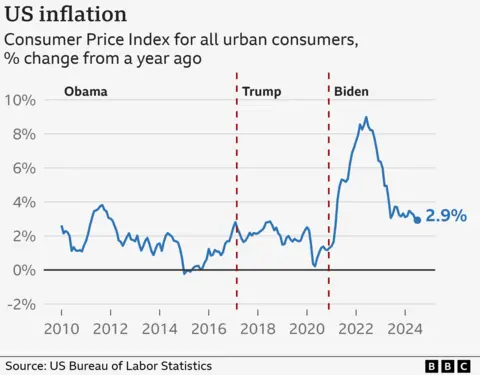 BBC News
BBC News
Grocery prices, for example, increased by 13.5% over the year ending in August 2022.
This was the peak under the Biden administration, and prices have stabilised somewhat since, with the cost of groceries rising by 1.1% from July 2023 to July this year.
The recent trend is comparable with many other Western countries which experienced high inflation rates in 2021 and 2022, as global supply chain issues driven by Covid and the war in Ukraine contributed to rising prices.
But some economists say Mr Biden’s $1.9tn (£1.5tn) American Rescue Plan, which passed in 2021, was also a factor - as the injection of cash into the economy led to prices rising further.
Employment
The Biden administration has repeatedly pointed to strong job growth as a major achievement.
Before big job losses in 2020 due to Covid, in the first three years of Trump's presidency almost 6.7 million jobs were added, according to data for non-farm jobs (which covers about 80% of workers in the labour force).
There's been an increase of almost 16 million jobs since the Biden administration took over in January 2021.

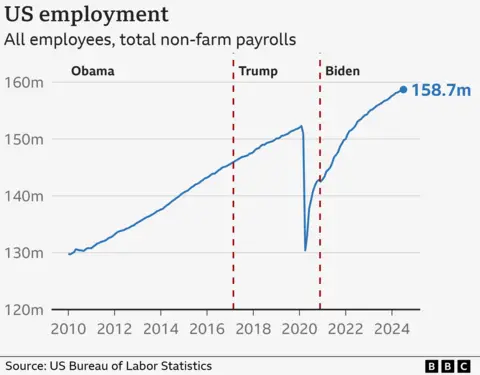
Mr Biden claims this is the “fastest job growth at any point of any president in all of American history”.
That’s correct - if you look at the available data since records began in 1939.
But his administration has benefited from a sharp rebound in economic activity as the country emerged from pandemic lockdowns.
“Many of the jobs would have come back if Trump had won in 2020 - but the American Rescue Plan played a major role in the speed and aggressiveness of the labour market recovery,” says Professor Mark Strain, an economist at Georgetown University.
This spending plan passed under the Biden administration in 2021 was designed to help stimulate the economy following the pandemic.
Weaker than expected job growth in July led to fears of a sudden downturn in the US economy and stock markets were hit as a result, but they've since stabilised.

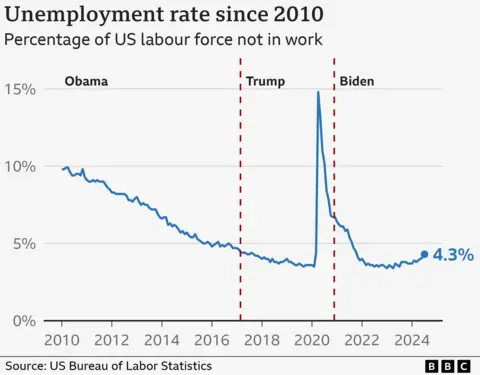 BBC News
BBC News
Both administrations have pointed to low unemployment levels under their leadership.
Prior to the pandemic, Mr Trump delivered an unemployment rate of 3.5%.
As in many parts of the world, Covid lockdown measures led to soaring levels of unemployment in the US - but the unemployment levels had dropped back down to around 7% when Trump left office.
Under the Biden administration unemployment continued to fall to a low of 3.4% in January 2023 - the lowest rate in more than 50 years - but it it has since ticked up to 4.3%.
Wages
In terms of wages, these did rise under Trump but at a similar rate to his predecessor Barack Obama, up until the pandemic hit.
Workers’ wages increased rapidly at the start of 2020 during the Covid pandemic - but the sudden uptick in wages was linked to lower paid workers being more likely to be laid off, which raised the average wage of people who were still employed.
Under Mr Biden, average weekly earnings have grown, but they have struggled to keep up with the increase in prices caused by high levels of inflation.
When adjusted for inflation, average weekly wages are less than when Mr Biden came into office.

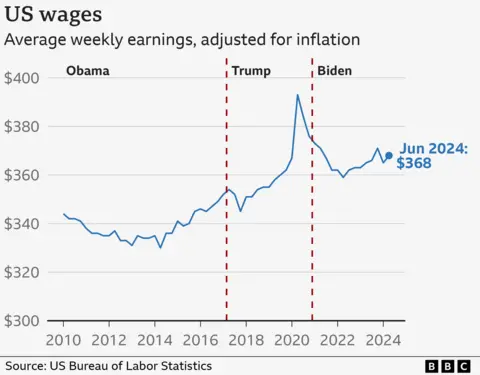 BBC News
BBC News
Financial markets
The US stock market isn't necessarily a reflection of the broader economy, but many Americans have investments, so its performance holds some importance.
The Dow Jones Index is a measure of the performance of 30 large companies listed on US stock exchanges.


It reached record highs during Trump’s presidency, but crashed as markets reacted to the pandemic, wiping out all the gains made under Trump.
However, the financial markets recovered to above pre-pandemic levels by the time Trump left office in January 2021.
They have continued to grow under Mr Biden, and although there have been recent wobbles, they have reached record levels under his administration as well.
Graphics by Tommy Lumby.



 2 months ago
11
2 months ago
11

